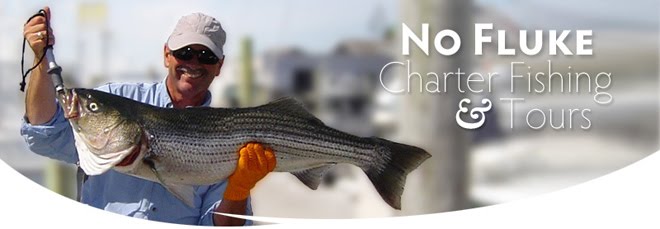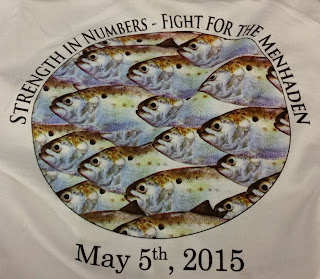Battle of the shirts: fishermen, charter captains and conservationists with white coalition t-shirts faced off with Omega Protein (who had their own orange shirts) Tuesday at the Atlantic menhaden board meeting where catch limits were increased 10%.
John Migliori with a 4 pound 12 once largemouth bass he caught on Aquidneck Island using a Schadeycreek Chartreuse Dynamite Lure.
ASMFC increases Atlantic menhaden catch limit
In a sixteen to one vote the
Atlantic menhaden board of the Atlantic States Marine Fisheries Commission (ASMFC)
approved a 10% increase (a total of 187,880 metric tons) in Total Allowable
Catch (TAC) for the 2015 and 2016 seasons.
The vote which occurred Tuesday at the ASMFC spring meeting included
Rhode Island representatives supporting and voting for 10% more Atlantic
menhaden to be taken from coastal waters and Narragansett Bay.
The vote for the increase came with
a lot of drama as Omega Protein employees who are members of Local 400 of the
United Food & Commercial Workers Union testified about the economic impact
Atlantic menhaden reductions had on employees two years ago. A union spokesman had about 40 union members with
bright orange t-shirts said, “We brought many more Union members in 2012, the
ones you see standing here today represent the number that were laid off due to
a 20% quota reduction in 2012.”
Atlantic menhaden (or pogies as
they are commonly called in New England) are used as bait fish for recreational
anglers to catch striped bass and blue fish as well as lobstermen and crab
fishermen as bait in their traps.
However, they are most often caught by Omega Protein, a Texas based
company with a big presence in Virginia.
Omega Protein takes over 80% of all Atlantic menhaden landed in the
United States to process for fish pills, fertilizers, pet food and a variety of
other uses.
Members of the Herring Alliance who
formed an Atlantic menhaden conservation coalition and attended the Board
meeting Tuesday wore white shirts that said, “Strength in numbers – Fight for
the Menhaden.”
Members of the menhaden coalition
included conservation groups, recreational fishermen and charter captains. They and just one menhaden board member (from
the U.S. Fish & Wildlife Service) were opposed to any catch limit increase
as ecological reference points had not been established for the species. Ecosystem-based management practices had not
fully been considered in the Board’s recommendation to increase catch limits.
Patrick Paquette, a charter captain
from Cape Cod testified before the committee, “Atlantic menhaden use to be
plentiful in our area, but today it’s hard to find any. The 2014 Atlantic menhaden stock assessment commissioned
by this Board could not find enough menhaden anywhere north of Rhode Island to
include in the assessment.”
Recreational anglers in Rhode Island
fear this decrease in fish is coming their way even though the 2014 stock
assessment showed an increase in biomass and said the species were not overfished
and overfishing was not occurring. The assessment
also showed that in recent years Atlantic menhaden were not being born
(recruited) in the numbers they once were, even though more were in the
water. Many believe the 20% reduction in
total allowable catch instituted in 2012 was the primary reason for an enhanced
biomass in 2014.
Robert Ballou of the Rhode Island Department
of Environmental Management who heads up Rhode Island’s delegation to the ASMFC
said, “We voted to approve the increase, but nothing is straight forward. Our intent was to approve an increase but
believe these catch limits are a bit too high as they will have less than a 50%
chance of reaching our desired targets.
It’s a matter of what degree of risk you want to take to establish catch
limits.”’
Ballou said “We also voted for the
increase because the second part of the motion called for the initiation of
Amendment 3 to the Atlantic Menhaden Fisheries Management Plan for the development
of Ecological Reference Points (ERP) and allocation.”
“What this means is that the Board
will fully consider the value and impact that Atlantic menhaden has as a forage
fish (food for striped bass, bluefish, tuna, whales, etc.) and not just
consider its value as a species target by directed fisheries (commercial
processors and bait fisheries).” said Ballou. The motion also referenced
allocation. Once ERP are established, adjustments
in total allowable catch may be made and the Board would look at allocating
more fish to states like Rhode Island that have very small quotas. Ballou said, “This is another reason why we
supported the vote to increase quota.”
Dave Borden, one of three RI ASMFC
representatives said, “We voted for the increase but I found eight things wrong
with this (Atlantic menhaden) Fisheries Management Plan (FMP). One major item is the bycatch provisions. It
does not make sense to allow boats in some states to have a bycatch allowance
that far exceeds Rhode Island total allowable catch limit for directed fisheries.” Rhode Island’s catch limit is approximately
66,779 pounds; Virginia’s catch limit is 318,066,790 pounds.
“I am voting for an increase in
Atlantic menhaden because the assessment shows that there are more fish in the
water.” said Eric Reid, who is Rhode Island Senator Susan Sosnowski’s newly
appointed proxy to the ASMFC. Reid, general
manger of Seafreeze, Ltd., a fish processor located in Narragansett, RI, replaced
Capt. Rick Bellavance, president of the Rhode Island Party & Charter Boat
Association as Senator Sosnowski’s proxy.
All ASMFC state members voted for the Atlantic menhaden catch limit
increase.
NOAA seeks comments on bluefish quota reduction
The
Mid-Atlantic Fishery Management Council recommended a 12% decrease in the
Annual Catch Limit (ACL) of Atlantic bluefish.
The reduction recommendation in quota was done to account for changes in
the stock size outlined in the 2014 stock assessment update.
The National
Oceanic & Atmospheric Administration (NOAA) is seeking input on the planned
commercial harvest limit of 5.12 million pounds, a 31% decrease from the 2014
quota, and the proposed recreational harvest limit of 13.07 million pounds, a
3% decrease from 2014. In recent years
state landings of bluefish have typically been below their allocated quota so
the proposed quota reductions may be partially mitigated by a state’s ability
to transfer quota.
Based on
the estimates from recent updated stock assessment, the bluefish stock is not
overfished and overfishing is not occurring.
Read the proposed rule, and submit your comments through the Federal eRulemaking portal online by May 12, 2015. Comments may also be submitted in writing
to: John K. Bullard, Regional Administrator, NMFS, Greater Atlantic
Regional Fisheries Office, 55 Great Republic Drive, Gloucester, MA
01930. Please mark the outside of the envelope: "Comments on Bluefish
Specifications."
Striped Bass American Heritage Act
Noted underwater photographer Mike Laptew has teamed up
with the Recreational Fishing Alliance (RFA) to advocate for the Striped Bass
American Heritage Act. The Act is a bill
put before US Congress last week to designate the striped bass as the National
Fish. The bill is sponsored by Congressman Tom MacArthur. Mike Laptew who is noted for his underwater
filming of striped bass (and other species) is urging all to call or write
members of their congressional delegation asking for their support for the
Striped Bass American Heritage Act.
Where’s the bite
Freshwater fishing remains strong. “The golden trout program run by
DEM was the ticket this weekend. Any
place they put them anglers were catching them including Silver Spring Lake in
North Kingstown.” said John Wunner of John’s Bait & Tackle. “Bass fishing
has really picked up.” said John Littlefield of Archie’s Bait & Tackle,
Riverside. The bass bite is good at
Stump Pond, Lincoln Woods, and Echo Lake in Barrington.” said Littlefield.
Striped bass. Ken Ferrara of Ray’s Bait & Tackle, Warwick, said
“School striped bass are being caught all over the Bay including Apponaug Cove,
East Greenwich Cove and in the East Passage.
At Rocky Point a customer was catching school bass on worms and then
switched to white soft plastics when he ran out and landed a keeper size bass.”
Things broke wide open this week said Manny Macedo of Lucky Bait & Tackle,
Warren. “We have school bass all over with customers catching keepers mixed it
at Colt State Park and other locations in the East Passage.” Mike Wade of Watch
Hill Outfitters, Westerly said “We got a pretty good shot of the striped bass
this week with a lot of fish being caught at the West Wall. Christian who works for me caught fifteen
fish, all in the 25” to 27” range using a small bucktail jig with pork rind
bouncing it off the bottom.” Elisa
Martin of Sung Harbor Marina, South
Kingstown said, “Anglers at the West Wall are catching 10 to 20 fish many in
the 24” range.” “Bass are in the Seekonk
River and Sunday Capt. Billy Silvia saw a school of bass chasing pogies near
Ohio Ledge in the East Passage.” said Dave Henault of Ocean State Tackle. “One of my good customers caught a nice
school bass using a pencil popper lure near Jamestown Saturday.”, said John
Littlefield of Archie’s Bait & Tackle, Riverside. Angler Mike Swain of Coventry said “I caught
my first bass this morning in East Greenwich Cove on the east side off Godard
Park using a soft plastic bait.” John
Wunner of John’s Bait & tackle North Kingstown said, “The bass are in at
Chepiwanoxet Point, Greenwich Bay and in Greenwich Cove.”
“Tautog fishing has been good in the low water spawning areas..
Small worms and clams are the bait of chose in spring as tautog like soft baits
in the spring.” said Mike Wade of Watch
Hill Outfitters. Dave Henault of Ocean
State Tackle said, “The tautog bite has been slow. Those angler targeting tautog are not finding
them yet.” “The tautog bite at
Barrington Bridge was pretty good this week.” said John Littlefield of Archie’s
Bait & Tackle. Macedo of Lucky Bait said, “Keeper tautog have been cauth
off Newport and north of the Mt. Hope Bridge.”
“Squid are in.”, said Dave Henault of Ocean State. They arrived at Goat Island, Newport and
under the Newport Bridge Friday night.
Capt. BJ Silvia ran into some Sunday while fishing in the Newport
area.” Squid are in from the southern
coastal beaches according to Elisa Martin of Snug Harbor to the Sakonnet River
said Manny Macedo of Lucky Bait.









